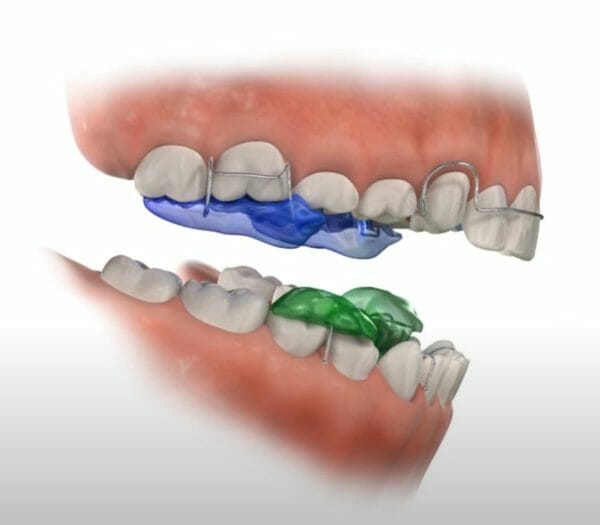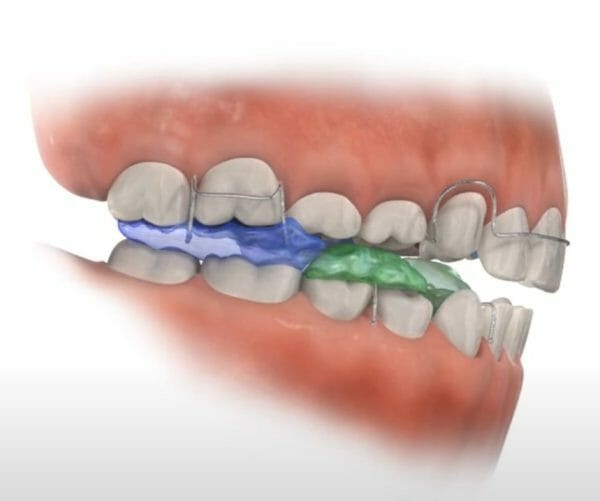A Comprehensive Overview for Orthodontic Treatment
Orthodontic treatment has come a long way in recent years, with advancements in technology and techniques leading to improved patient outcomes. Among the various approaches, functional appliances have proven to be an effective method for correcting malocclusions and promoting proper jaw development in growing children and teenagers.
Twin Block and Bionator appliances are two of the classic functional devices used by orthodontists, although not used commonly in our practice. At Burke & Redford Orthodontists, with offices located in Temecula and Lake Elsinore, California, we more typically use other functional appliances that achieve a similar result with less reliance on patient compliance.
Our doctors want to provide a comprehensive overview of these appliances, their benefits, and the role they play in orthodontic treatment.
Twin Block Appliance
The Twin Block appliance, developed by Dr. William J. Clark in the late 1970s/early 1980s, is a removable orthodontic device that consists of two separate components – one for the upper jaw and one for the lower jaw.
These components work in tandem to reposition the lower jaw forward, correcting Class II malocclusions, which are characterized by an overjet or overbite.
The Twin Block appliance is designed for patients in their growth phase, as it leverages natural growth patterns to achieve optimal results.

Benefits of Twin Block Appliance
- Effectiveness: Twin Block appliances have proven to be highly effective in treating Class II malocclusions, leading to improved facial balance and dental function.
- Flexibility: The appliance is removable, allowing patients to maintain their oral hygiene and enjoy regular meals without interference.

Bionator Appliance
The Bionator appliance, developed by Dr. Balters in the 1950s, is another removable orthodontic device used to treat Class II malocclusions.
Like the Twin Block appliance, the Bionator consists of upper and lower components that work together to guide the lower jaw forward.
The Bionator appliance is designed to be worn during the patient’s growth phase, also making it most effective for younger patients who are still developing.
Benefits of Bionator Appliance
- Effectiveness: Bionator appliances have shown positive results in correcting Class II malocclusions and promoting proper jaw development.
- Minimal Interference: Since the Bionator is removable, patients can maintain their oral hygiene and enjoy regular meals without difficulty.

Twin Block and Bionator appliances are both effective, functional orthodontic devices that have demonstrated success in correcting Class II malocclusions and promoting proper jaw development.
By leveraging the natural growth of a patient, these appliances offer a non-invasive approach to orthodontic treatment.
When functional appliances were first developed, orthodontists believed that their results were due to the creation of excess new lower jaw growth. While it appears that the lower jaw grows significantly during functional appliance use, we are really bringing (pre-programmed) growth forward in time more than we are creating new lower jaw growth. In other words, these appliances are very effective at correcting overbites, but there is nothing “magical” about stimulating extra jaw growth.
At Burke & Redford Orthodontists, our experienced orthodontists provide our patients with the most effective and comfortable treatment options. While the Twin Block and Bionator appliances are effective, other types of functional appliances (ie. the Herbst appliance) are more commonly used in our office.
Choosing the Right Appliance
The decision to use a Twin Block or Bionator appliance for orthodontic treatment is based on several factors, including the patient’s age, severity of the malocclusion, and the specific needs of the patient.
Dr. Ryan Redford and Dr. Michael Burke have over 40 years of combined experience treating patients in Southern California. Each doctor will thoroughly evaluate each patient and determine the most suitable treatment plan for their unique circumstances.
Patient Compliance and Follow-up Care
Both Twin Block and Bionator appliances require consistent wear and proper care for successful treatment outcomes. As these devices are heavily dependent on patient cooperation, other treatment options (Ie. the Herbst appliance) will likely be advised.
The Role of Twin Block and Bionator Appliances in Comprehensive Orthodontic Treatment
Twin Block and Bionator appliances are often used as part of a comprehensive orthodontic treatment plan that may also include braces or other orthodontic devices.
These appliances are generally used around the pubertal growth spurt to correct jaw imbalances and correct excess overbites.
Once the functional appliances have achieved the desired results, our doctors may transition the patient to braces or Invisalign to fine-tune tooth alignment and achieve the best possible outcome.
When using these appliances as part of a comprehensive treatment plan, Dr. Ryan Redford and Dr. Michael Burke can effectively correct jaw imbalances, promote proper development, and create beautiful, healthy smiles for their patients.
To learn more about the Twin Block and Bionator appliances or other orthodontic treatment options, please contact Burke & Redford Orthodontists during business hours, Monday through Thursday from 8:30 a.m. to 5 p.m., by calling (951) 699-8011. You may also fill out the Free Orthodontic Consultation form on our website anytime.
References:
Clark, W. J. (1982). The Twin Block technique. A functional orthopedic appliance system. American Journal of Orthodontics and Dentofacial Orthopedics, 82(1), 1-18.
Illing, H. M., Morris, D. O., & Lee, R. T. (1998). A prospective evaluation of Bass, Bionator, and Twin Block appliances. Part I – The hard tissues. European Journal of Orthodontics, 20(5), 501-516.
Mills, C. M., & McCulloch, K. J. (1998). Treatment effects of the Twin Block appliance: A cephalometric study. American Journal of Orthodontics and Dentofacial Orthopedics, 114(1), 15-24.